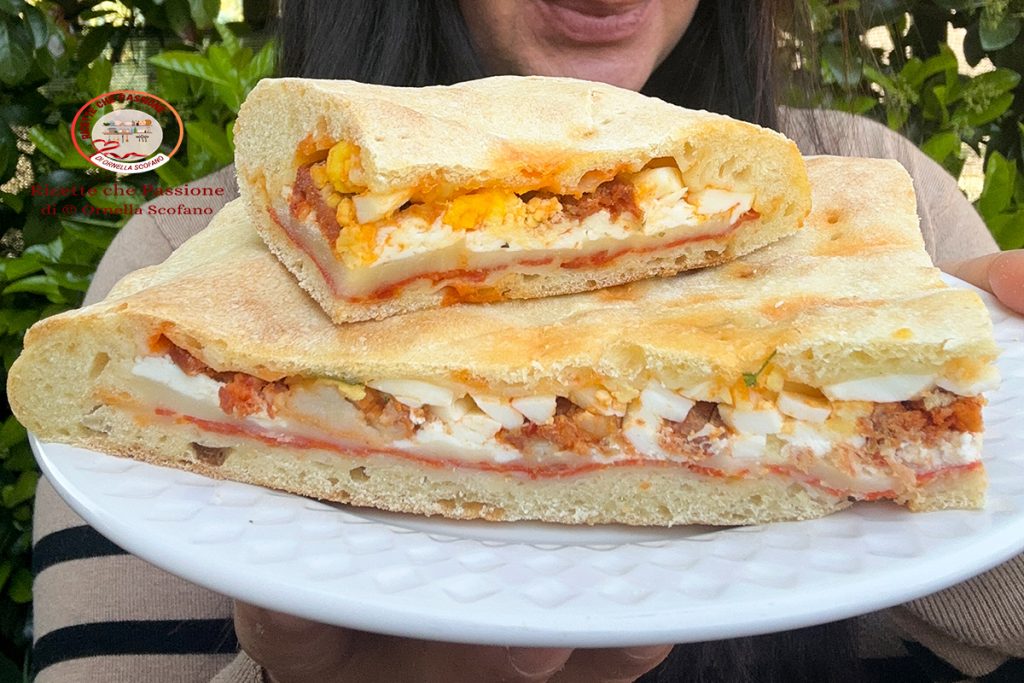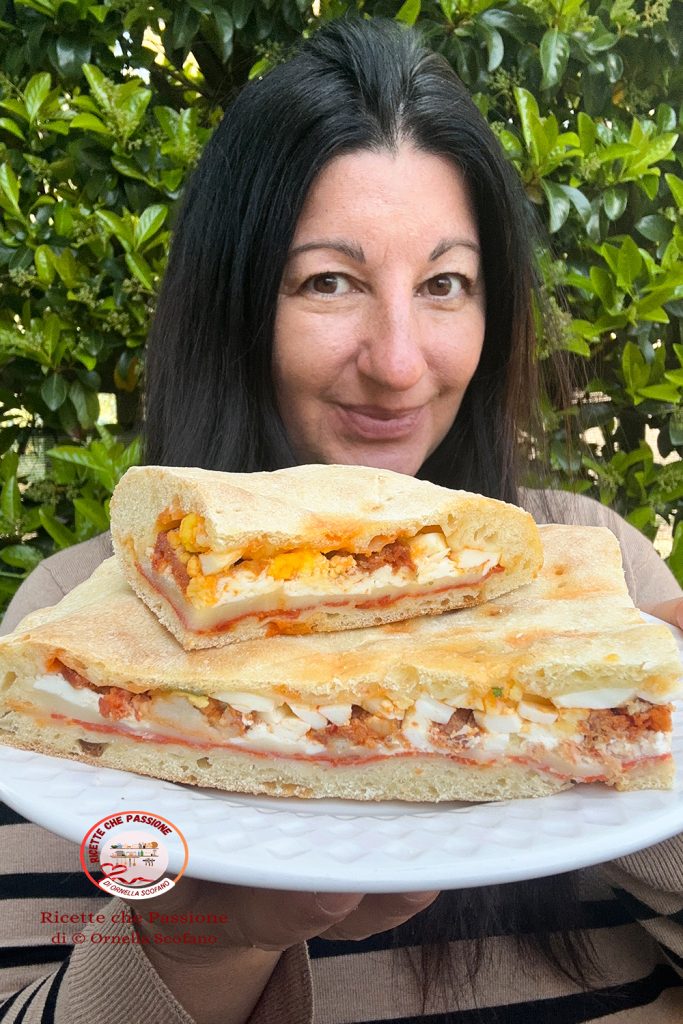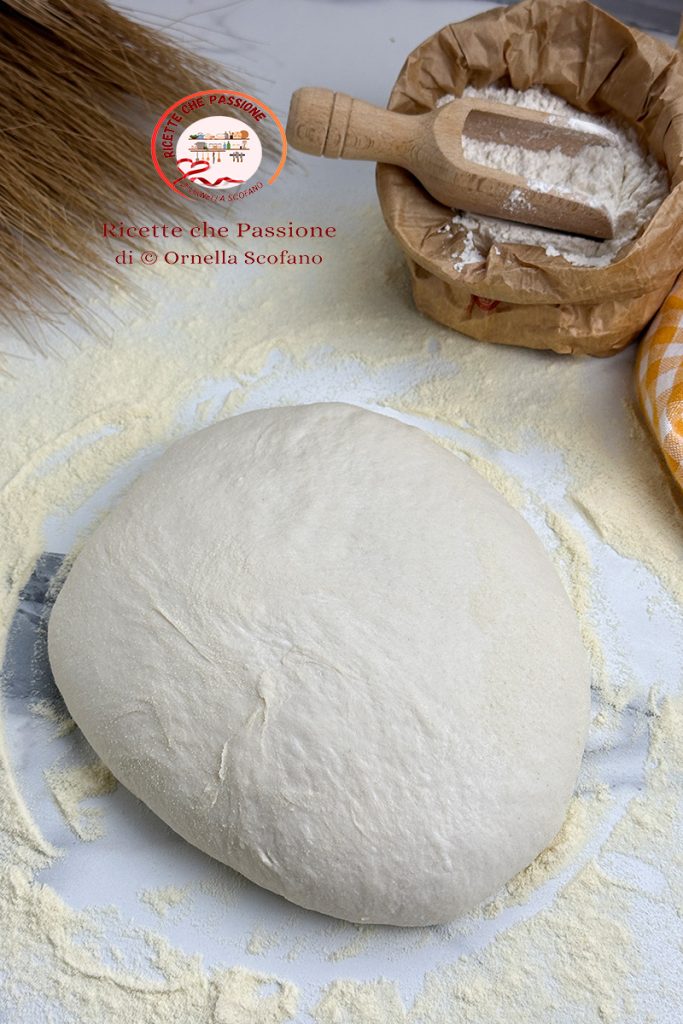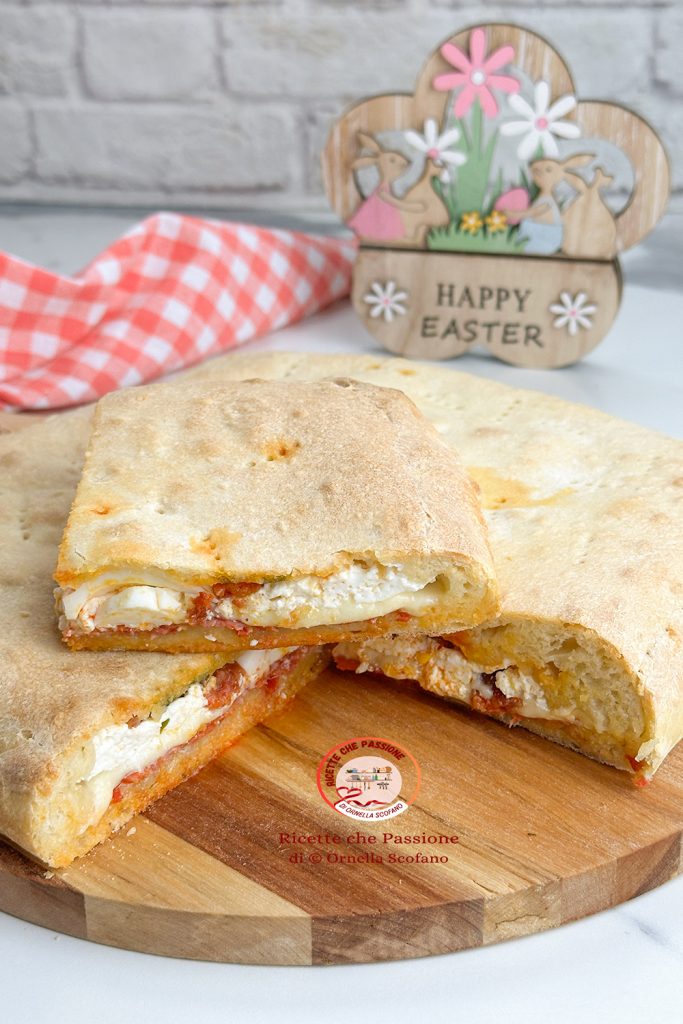Easter is coming and in Calabria it is traditional to make pitta chjina in a wood-fired oven. The name of the pitta chjina can vary depending on the locality, in Lamezia Terme it is known as guastella, in the Cosenza area mbignulata, mpiulatu or mbiulata, and it can slightly differ from locality to locality for the ingredients used in the filling, for example in the Lamezia area they use cooked pork rind, while in the Cosenza area they use frisuraglie, which are pork cracklings. The base is a bread dough, made with durum wheat flour, kneaded by hand and baked in a wood-fired oven. Since I prepare it in my home oven, I have experimented and perfected my preferred dough, a semolina dough for focaccia. I use little yeast, type 0 flour and re-milled durum wheat semolina, and I just add a drizzle of oil to make it beautifully golden and crispy on the outside, while it remains very soft inside. However, let’s go back to the filling which deserves special mention. The filling consists of all the typical Calabrian ingredients found during the Easter period. Homemade cured meats, as was the Calabrian tradition, soppressata and aged sausage, sheep cheese a few days old, and fresh sheep ricotta, hard-boiled eggs from the backyard chickens, which were never missing, and then cracklings or pork rind and abundant parsley. A sumptuous and rich filling that after the long period of Lent, of deprivations and sacrifices, symbolized a wish for abundance and a good harvest for the months to come, with the harvest of wheat and every other production or breeding. The rite of Easter bread saw families gather around the ovens, to prepare bread in large quantities, imagine kneading 20 kg of flour per family, then those who prepared it first would donate to neighbors who hadn’t prepared it yet or perhaps couldn’t prepare it because they didn’t have an oven, or because they were in mourning, and as a sign of mourning, they deprived themselves of any pleasure. Even though we are in 2025, in many rural districts the rite of Easter bread remains, indeed, almost every year I return to the countryside to my mother’s and we go to prepare Easter bread in the neighbor’s oven, we prepare it during Holy Week, between Thursday and Saturday so that we take turns with others who make bread in the same oven, we usually take a whole morning to bake, remove, fill, and taste, we simultaneously prepare in this order, pizza, bread, and pitta chjina and finally also desserts, the mythical cuzzupe or cuddura cu l’ova of Easter are never missing.

- Difficulty: Easy
- Cost: Medium
- Preparation time: 30 Minutes
- Portions: 8
- Cooking methods: Oven
- Cuisine: Italian
- Seasonality: Easter, Spring
Ingredients for Calabrian Pitta Chjina
- 2 cups cups type 0 flour
- 2 cups cups re-milled durum wheat semolina
- 1 1/3 cups cups water
- 2 tsp tsp fine salt
- 1 tbsp tbsp olive oil
- 1 1/2 tsp tsp fresh yeast
- 5.3 oz oz aged Calabrian sausage
- 3.5 oz oz aged Calabrian soppressata
- 5.3 oz oz fresh pecorino cheese
- 7 oz oz sheep or mixed ricotta
- 4 hard-boiled eggs
- to taste parsley
- to taste cracklings (optional as not everyone likes them)
Tools for preparing Calabrian Pitta Chjina
- 1 Bowl
- 1 Spoon
- 1 Cling Film
- 1 Cutting Board
- 1 Knife
- 1 Tray
- 1 Pastry Board
- 1 Baking Pan
Steps for preparing Calabrian Pitta Chjina

We prepare the dough at least 5 hours in advance. If before, even better. In a bowl, dissolve the yeast in water and then add the type 0 flour and mix with the spoon. Add a little semolina, the salt, and continue mixing well with the spoon. Then add the rest of the flour and when the dough becomes more solid, knead by hand. Finally, add the oil and work the dough to incorporate it completely. Knead well and place it back in the bowl, cover with cling film, and let it rise. For a warm rise at about 82°F, it takes about 4 hours. I do it in the oven with a pot of hot water and the light on. For lower temperatures, the times are longer.
Once the dough has risen, we take it and form 2 small loaves, and let them rise for about an hour, in a warm place. Meanwhile, we prepare the filling.

Slice the salamis and cheese, prepare the hard-boiled eggs by cooking them for 5 minutes from boiling, place them in cold water, and peel them when cooled. Wash and drain the parsley. When the eggs are cold, slice them.
Once the small loaves have risen, we take them, roll them out, one at a time, to form the base and top of the focaccia, working on a floured surface by hand, without a rolling pin. I used a square baking pan, but a round one of 12-14 inches in diameter works as well.
Flour the base of the rolled-out dough well and line the non-stick mold, or if you prefer, use baking paper at the base.
We start filling, with the cracklings if using, or directly with the cheese slices, trying to cover the entire base, then with soppressata, then the sausage, the ricotta and eggs, and finally the chopped parsley.
Close with the second disc. Seal the edges well by folding and pinching the base dough with the top. Once done, poke the surface with a fork and press to release all the air.
Bake in a hot ventilated oven at 482°F for about 20 minutes, until it is golden on the surface.
Remove from the oven and place a weight on top, even a frying pan, to compact the filling well. Of course, if you can resist not tasting it right away, hot and steaming. Usually, we prepare about ten of them and stack them on top of each other, so the filling evens out.
Usually, they are not refrigerated, kept at room temperature in cool, dark rooms, and enjoyed at room temp. Since we don’t have the conveniences of the past, I put it in the fridge if it lasts and warm it slightly.


